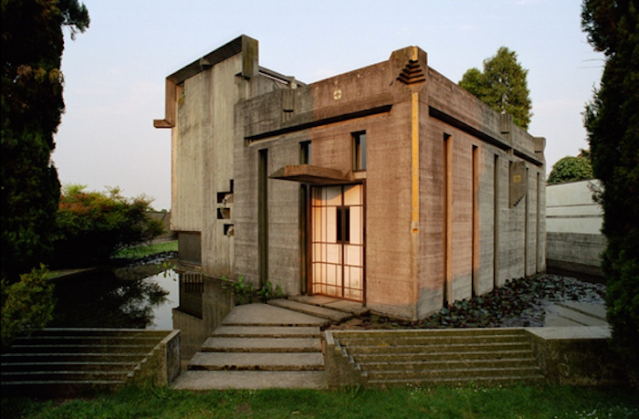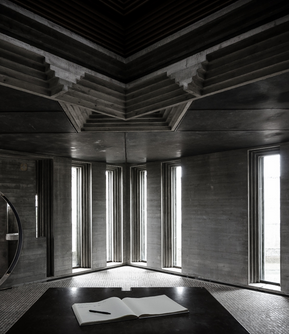
Tomba Brion (Brion Cemetery), near Treviso, Italy, by Carlo Scarpa. (Pinterest)
The identity of my favorite modernist architect has always eluded me.
I am not familiar with the work of every modernist. But modern architecture is by its nature inferior to traditional architecture. At its heart is a rejection of the past, a past that never deserved rejection, and a rejection of precedent, a design strategy that rarely works, and which places modern architecture outside the circle of almost every human endeavor. Every field has sought to improve on past technique and forge best practices by trial and error handed down generation to generation over the years, decades and centuries. This model of growth was rejected by the modernists, and it shows.

Interior of Brion tomb. (
After lifelong contemplation, I must tentatively conclude that the Italian architect Carlo Scarpa, who said, “I have always had an immense desire to belong to tradition, but without having capitals and columns,” is my favorite modernist architect.
In line with this desire, his work is mostly placed within the historical settings of his native Italy, which is far less open than other countries to new architecture that contradicts history and beauty. In his chapter on the Venice-born Scarpa in Makers of Modern Architecture II, the critic Martin Filler compares Scarpa with, among others, Louis Kahn:
By 1950 these two introspective and artistically ambitious men had become repelled by the spiritual emptiness and generic sameness of International Style architecture in its later, corporate phase. To redress what they saw as the loss of physical and emotional substance in modern building, they looked back at the architecture of the past, not in an attempt to imitate or revive it but instead to extract its vital essence and reinterpret it for their own time in new and pertinent ways.
Scarpa did this far better than Kahn, whose work has never seemed to relate much to the past. Of course, Scarpa would have done himself, his profession and his world a service if he had not ejected columns and capitals from his work. Filler makes more sense linking Scarpa to Frank Lloyd Wright, whose reverence for the past also didn’t extend to columns or capitals, but still carried him through his best work, until he drank the Kool Aid.
Filler asserts that Wright
inspired Scarpa to use embellishments that are of a building rather than on it, just as he maintained that a house should be of a hill rather than on it. Such characteristic Scarpan motifs as horizontal rows of lines stepped inward or outward to imply a Classical molding can be traced directly to Wright, who seemed to offer a viable third way between politically tainted Classicism and globally generic Modernism.
I needn’t add that the political taint of Classicism was and is unjustified. Filler adds that Wright’s architecture, “with its profoundly rooted sense of place, could not be transplanted as readily as the aptly named International Style, which could be erected on virtually any site anywhere.”
This is supposedly an advantage that Scarpa refused to indulge, but what diminishes his work is his willingness to plop in flat, shiny, unadorned patches on his pleasing stone walls. This usually spurns the sense of place, and degrades the ability of his work to reach out to the past. Filler uses one of his favorite words, palimpsest, to describe what most would see as the incoherence of such splotches. Scarpa was as reluctant as any modernist to acknowledge that too much material diversity undermines the ability of design to achieve unity. Still, ugly superimposed on beauty is better than ugly superimposed on ugly. You have to hand him that.
Filler quotes architect George Ranalli, who served as dean of architecture at City College of New York from 1999 to 2017, that such “layering of history” sets up “a dialogue between old and new, provoking the older elements into conversation with the wholly invented new forms, surfaces, textures, and motifs.” Channeling Kahn, we can imagine such a “dialogue”:
Brick: Hey! Get your shiny mitts off my façade!
Platinum: Sorry. We’ve decided to gentrify this wall.
Brick: That’s no fair! We’re going to tell Maestro Scarpa!
Platinum: Don’t bother! He’s read Complexity and Contradiction. He doesn’t care what brick wants.
In describing Scarpa’s designs, Filler makes a point that unwittingly junks the validity of every aspect of his criticism. His line expressing the deep flaws of modern architecture puts him in league with other critics, who, like Filler, do not seem to understand its profound implications. Here is the line:
The American-style obliteration of the still-usable past seems in the Italian setting not merely economically profligate but culturally suicidal.
Not just the Italian setting but every setting of a certain age. Every new modernist building degrades its site, whether it replaces a beautiful older building (often resembling the box its predecessor might have come in) or a plain older building – or merely an empty patch of dirt. Filler is joined in what amounts to the same conclusion by Paul Goldberger and others. Sometime critic Rem Koolhaas has said much the same; he seems to recognize it but not to care.
I suppose absolutely zero is to be gained by reminding a modernist of an idea he has not thought of completely on his own. At least Carlo Scarpa thought sensible thoughts, if not quite enough of them – but enough to qualify as the least displeasing among the practitioners of modern architecture.
Scanning hundreds of Google images of his work as I sought illustrations for this post, my alarmingly positive assessment of Scarpa was shaken, but not entirely demolished. Feel free to chastise me for this apostasy.

Detail of Tomba Brion showing Scarpa’s dedication to molding-like details. (



PS: 135 Pratt Street is already for sale.
LikeLike
What is 135 Pratt St.? Stan’s place?
LikeLike
Yes. That was fast. Maybe a reaction to your review.
LikeLike
I’ve been to the Brion Vega cemetery. It’s a memorable place, but reinforced concrete does not age as well as stone or brick. On the same day, I went to the Villa Emo. An interesting contrast…
LikeLike
I might add here that I did the first session at the Society of Architectural Historians on “Architectural Palimpsests” in the 1990s. Barry Bergdoll and Kevin Murphy did papers for me. We should study this practice more assiduously in the near future.
LikeLike
I don’t fully accept Scarpa as “modernist” architect, and he didn’t necessarily count himself as one. Like Wright, he found his own voice, and language. He was the most successful architect at restoring and re-using historic buildings of the twentieth century, and therefore a visionary in more ways than one. He also drew obsessively, like a painter.
LikeLike
As you describe him, chaffing at the idea of being a “modernist” architect, he certainly does qualify as my favorite modernist, if you can call him that. And if I can be said to even have a favorite modernist, which is a highly dubious proposition, though in that sense everything is possible. My least detestable modernist, let us say.
LikeLike